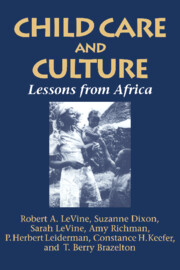Book contents
- Frontmatter
- Contents
- List of tables and figures
- Foreword
- Acknowledgments
- Introduction
- Part I African infancy: Frameworks for understanding
- Part II Parenthood among the Gusii of Kenya
- Part III Infant care and development in a Gusii community
- Part IV Interpretations
- Appendix A Fieldwork procedures: Initial phases and planning
- Appendix B Coding categories for spot observations
- Appendix C Blankhart Nutrition Questionnaire
- Appendix D Temperament Assessment Method
- Appendix E Coding categories for narrative observations
- Appendix F Coding categories for face-to-face interaction
- Appendix G Coding categories for maternal teaching task
- Appendix H Supplementary tables
- Notes
- References
- Index
- Plate section
Appendix A - Fieldwork procedures: Initial phases and planning
Published online by Cambridge University Press: 11 May 2010
- Frontmatter
- Contents
- List of tables and figures
- Foreword
- Acknowledgments
- Introduction
- Part I African infancy: Frameworks for understanding
- Part II Parenthood among the Gusii of Kenya
- Part III Infant care and development in a Gusii community
- Part IV Interpretations
- Appendix A Fieldwork procedures: Initial phases and planning
- Appendix B Coding categories for spot observations
- Appendix C Blankhart Nutrition Questionnaire
- Appendix D Temperament Assessment Method
- Appendix E Coding categories for narrative observations
- Appendix F Coding categories for face-to-face interaction
- Appendix G Coding categories for maternal teaching task
- Appendix H Supplementary tables
- Notes
- References
- Index
- Plate section
Summary
The Gusii Infant Study brought together a team of social and medical researchers for field research into infancy and parenthood in Kisii District, Kenya, from 1974 to 1976. Planning for the study began in June 1973 at the Wenner-Gren Conference on Cultural and Social Influences in Infancy and Early Childhood, in Burg-Wartenstein, Austria, where the pediatrician T. Berry Brazelton and P. Herbert Leiderman, a psychiatrist and organizer of the conference, proposed to Robert A. LeVine, an anthropologist, the idea of a collaborative field project in Africa to examine the environments and development of children from birth through the transition to early childhood.
Brazelton and Leiderman had conducted previous infant studies in Africa (in Zambia and Kenya, respectively), but what they had in mind this time was an intensive and extended multidisciplinary project that would permit understanding of the social and cultural contexts in which infants developed over the first 2 to 3 years of life. LeVine, having worked since the 1950s on child care in Kenya and Nigeria, had come to believe that the investigation of how children acquire culture must begin in infancy; the proposed project offered not only collaborators experienced in infant research but also the possibility of a research relationship in which the parents being studied would gain medical service for their children. It was decided to locate the study among the Gusii people in southwestern Kenya, among whom LeVine had initially worked from 1955 to 1957 (with Barbara B. Lloyd) and whom he had revisited in four briefer trips from 1964 to 1969.
- Type
- Chapter
- Information
- Child Care and CultureLessons from Africa, pp. 275 - 280Publisher: Cambridge University PressPrint publication year: 1994



